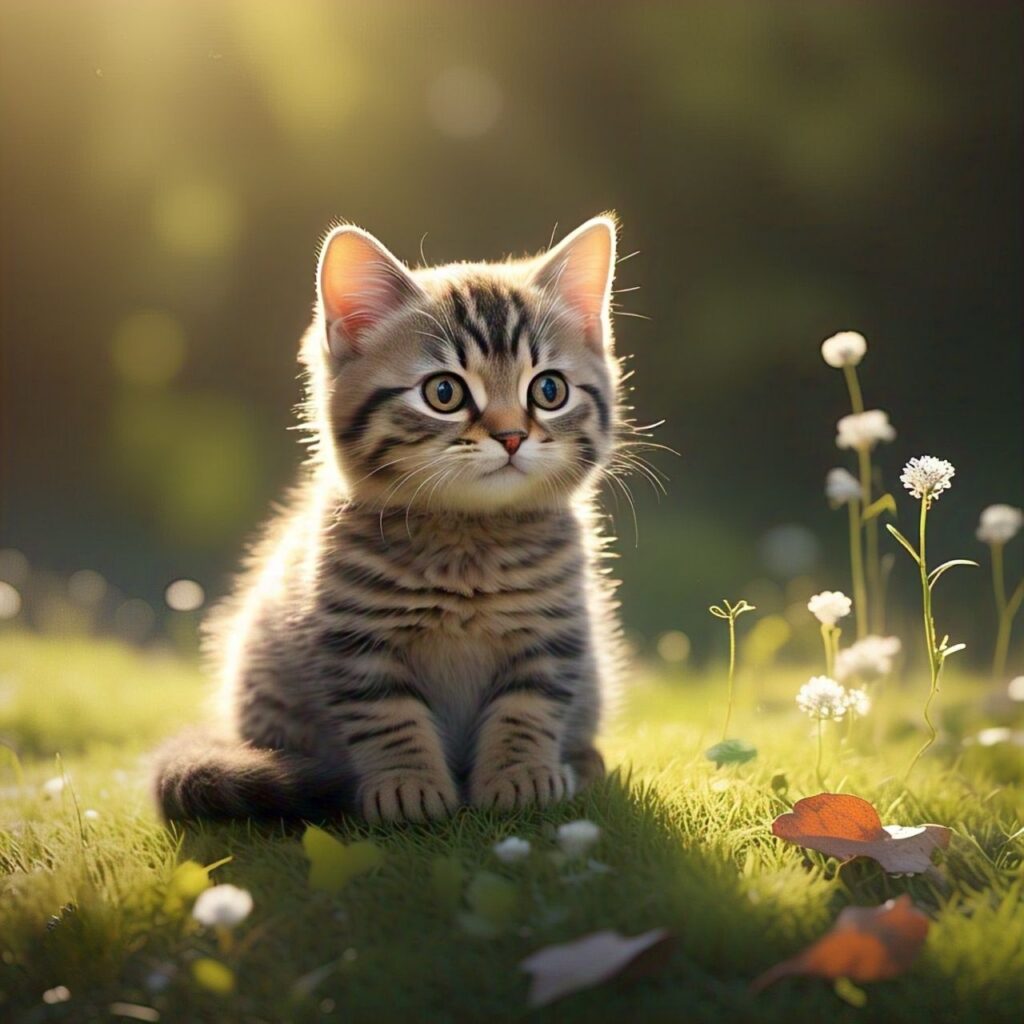Whether you’re a first-time cat parent or a seasoned pro, understanding what makes tabbies special can help you care for them better.
As a proud cat parent to three—including a beautiful black-and-white Persia—I’ve seen firsthand how different each cat’s personality and needs can be. If you’re curious about tabby cats and how to care for them, you’re in the right place.
Tabby Cats: Not a Breed, But a Pattern
Ever seen a cat with stripes, dots, or swirls on its coat? These stunning kitties are tabby cats, and their markings are as unique as fingerprints.
Tabby isn’t a breed—it’s a coat pattern that appears in many cat breeds and mixed-breed felines. What makes a tabby stand out is their bold and beautiful markings. They come in a variety of colors, including brown, gray,orange, black, and cream.
Here’s what you’ll typically notice on a tabby:
- Stripes: Most tabbies sport vertical or horizontal stripes across their bodies.
- Spots: Some have spots scattered across their coats.
- Swirls (Whorls): A marbled appearance with swirling patterns.
- Bands: Rings of color on their legs and tails.
- Dark “eyeliner” around the eyes.
- Pigmented lips and paws.
- Pale chins and bellies.
- Thin pencil lines on their faces.
- Bands or rings on their legs and tails.
M-Shaped Forehead: All tabbies have an “M” marking on their foreheads—like a natural crown.
🐾 Tabby Cat Personality Traits and History
Tabby cats are famous for their vibrant personalities and fascinating history. Known for their friendly and outgoing nature, tabbies are often described as playful, intelligent, and social. While their temperament can vary depending on breed and upbringing, many tabby owners agree they make wonderful companions.
Myths and Facts About Tabby Temperament
Despite being widely adored, tabbies face their fair share of myths. Let’s clear up a few misconceptions:
- Myth: All tabby cats are hyperactive.
Fact: Tabbies vary in energy levels. Some are highly active, while others are laid-back lap cats. - Myth: Tabbies are a breed.
Fact: Tabby refers to a coat pattern, not a breed. These patterns appear across various breeds and mixed-breed cats.
Fun Personality Facts
- Tabbies are often described as affectionate and curious.
- About 60% of cats are tabbies.
- Tabbies are tabbies even before they are born. Feline fetal cells, when viewed under a microscope, show patterns of thick and thin embryonic skin cells resembling the fur markings they will develop later.
- All orange cats are tabbies.
- 4 out of 5 tabbies are male, making male tabbies significantly more common than females.
History of the Tabby Cat
The tabby pattern is ancient—so ancient that it can be traced back to the African wildcat, believed to be the ancestor of all domestic cats. These markings likely helped wildcats camouflage in their natural environment, making them effective hunters.
The tabby’s distinctive “M” marking has sparked legends, with some linking it to religious or cultural stories. Historically, the name “tabby” is thought to originate from Atabi silk, a striped fabric made in the Middle East. The French called it tabis which translates to “tabby” in English. The tabby cat’s coat resembles this silk, and this is how the pattern got its name.
Famous Tabbies Throughout History
Tabbies have left their mark in history and pop culture:
- Delilah, Freddie Mercury’s beloved tabby, even had a song dedicated to her.
- Tabby, President Lincoln’s White House cat, was the first feline to live in the presidential residence.
- Orangey, the orange tabby, starred in Breakfast at Tiffany’s.
Physical Characteristics
| Characteristic | Level | Description |
|---|---|---|
| Affection Level | High | Tabbies are known to be loving and enjoy bonding with their humans. |
| Friendliness | High | They are social cats that adapt well to different people and environments. |
| Kid-Friendly | High | Tabby cats are great with kids and often become their playful companions. |
| Pet-Friendly | High | They typically get along well with other cats and even dogs. |
| Exercise Needs | Medium | Moderate activity keeps them healthy. They enjoy occasional play sessions. |
| Playfulness | Medium | Tabbies are curious and enjoy interactive toys but also appreciate downtime. |
| Energy Level | Medium | They are neither too hyperactive nor too lazy, making them adaptable pets. |
| Intelligence | Medium | Smart enough to learn tricks and solve puzzles, but not overly demanding. |
| Tendency to Vocalize | Medium | Communicative, but not excessively vocal. They’ll meow to let you know their needs. |
| Amount of Shedding | Medium | Regular grooming helps control shedding. |
Tabby Kittens: What to Expect
- Here’s how to care for them:
-
- Coat Maintenance: Weekly brushing is usually sufficient for tabbies to keep their coat healthy.
- Health Tips: Provide a balanced diet and regular vet check-ups to ensure long-term health.
- Socialization: Early exposure to various environments helps develop their friendly demeanor.
- Playtime: Use toys to keep them active and mentally stimulated.
- Nutrition: Feed them high-quality kitten food for healthy growth.
The Lifespan of a Tabby Cat📊
- Average Lifespan: 12-15 years.
- With good care, some tabbies can live up to 20 years.
- Lifespan varies based on health, breed, and living conditions.
Tabby Cat Breeds, Colors, and Types
Tabby Cat Types and Common Breeds
- The Classic (Blotched) Tabby
Features bold, swirling patterns resembling a marble cake.
Common in breeds like Maine Coon, British Shorthair, and American Shorthair. - The Mackerel Tabby
Known for narrow, vertical stripes similar to a tiger’s coat.
Often seen in Domestic Shorthair, Siberian, and Norwegian Forest Cats. - The Spotted Tabby
Distinct spots replace stripes, creating a unique dotted appearance.
Found in breeds like Bengal, Ocicat, and Egyptian Mau. - The Ticked Tabby
Lacks body stripes or spots, with hairs banded in multiple colors.
Rarely seen, but common examples include Abyssinian and Somali Cats. - The Patched Tabby (Torbie)
A blend of tortoiseshell and tabby patterns with red or cream patches.
Appears in breeds like Tortoiseshell Domestic Cats, Maine Coon, and Persian Cats.
Tabby Cat Breeds
Tabby markings can be found in both purebred and mixed-breed cats. Here are some popular tabby combinations:
- Piebald Tabby Cat: A tabby with white patches on the body.
- Tuxedo Tabby Cat: A mix of tabby and tuxedo markings, often showing white chests and paws.
- Mackerel Tuxedo Tabby Cat: A tuxedo cat with the mackerel tabby’s striped pattern.
- Calico Tabby Cat: Combines calico’s multicolor patches with tabby stripes or swirls.
- Harlequin Tabby Cat: Features large patches of tabby patterns with mostly white fur.
- Ragdoll Tabby Mixes:
- Blue Tabby Bicolor Ragdoll
- Seal Tabby Bicolor Ragdoll
- Tuxedo Tabby Mixes:
- Grey Tabby Tuxedo
- Brown Tuxedo Tabby
- Black Tuxedo Tabby
Tabby Cat Colors
Tabby cats come in a rainbow of colors, adding to their charm and variety:
-
Brown Tabby:
The most common tabby color, with black markings on a brown coat.
-
Grey (Silver) Tabby:
Features black markings on a pale silver or gray coat.
-
Orange Tabby:
Known for their vibrant orange fur and typically outgoing personalities.
-
Cream Tabby:
A softer, diluted version of the orange tabby.
-
Blue Tabby:
A rare, steel-blue variation with darker markings.
-
Black Tabby:
Subtle markings often visible only in bright light.
Gender-Specific Personalities
Female Tabby Cat Personality
- Often more independent and reserved than their male counterparts.
- Tend to be nurturing and affectionate once trust is established.
Male Tabby Cat Personality
- Known for their social and outgoing nature.
- Many male tabbies are playful, curious, and enjoy human interaction.
Tabby cats’ variety in types, breeds, and colors ensures there’s a perfect tabby for every cat lover. Whether you’re drawn to their striking patterns or vibrant personalities, these cats are sure to bring joy to any home! 😸

